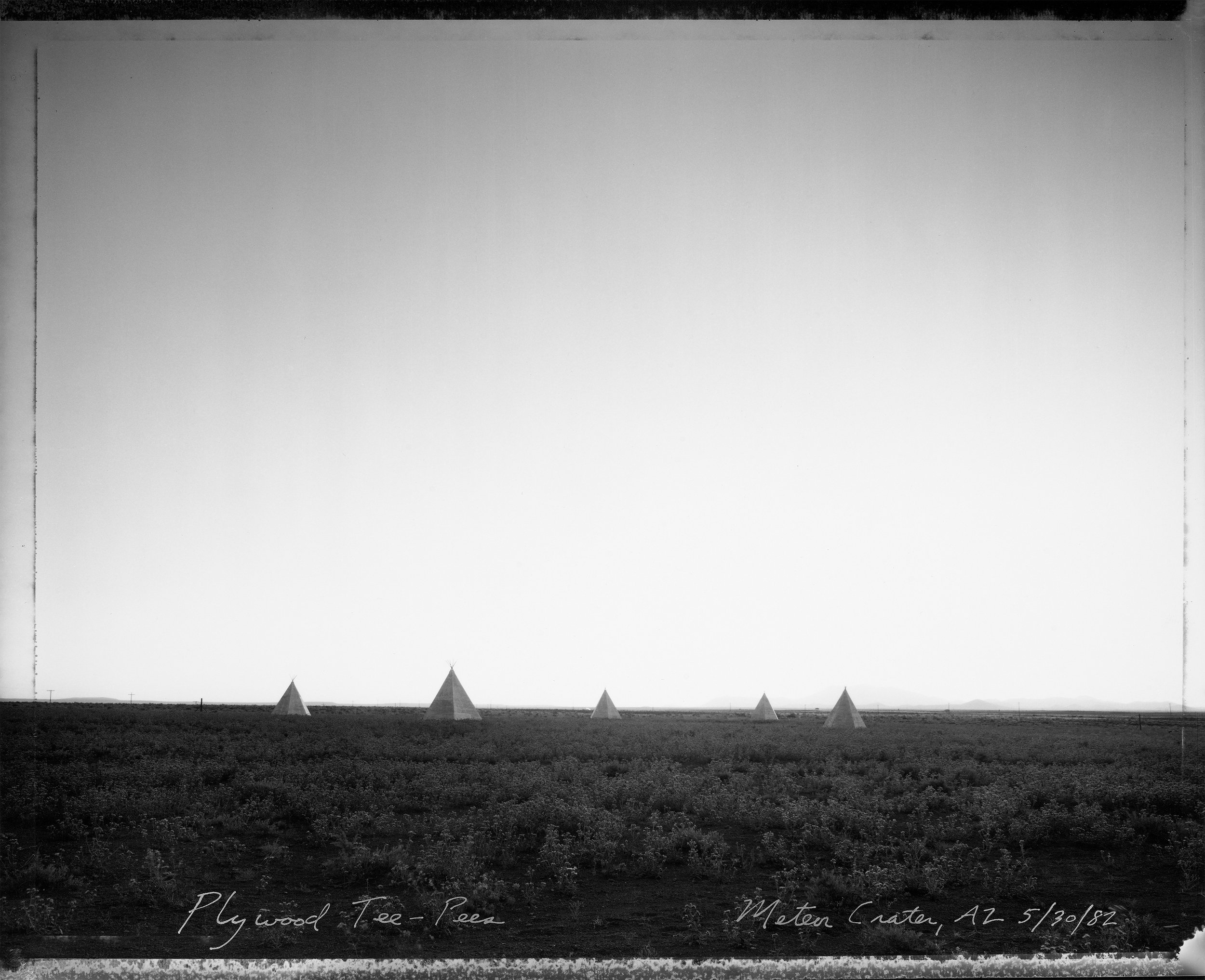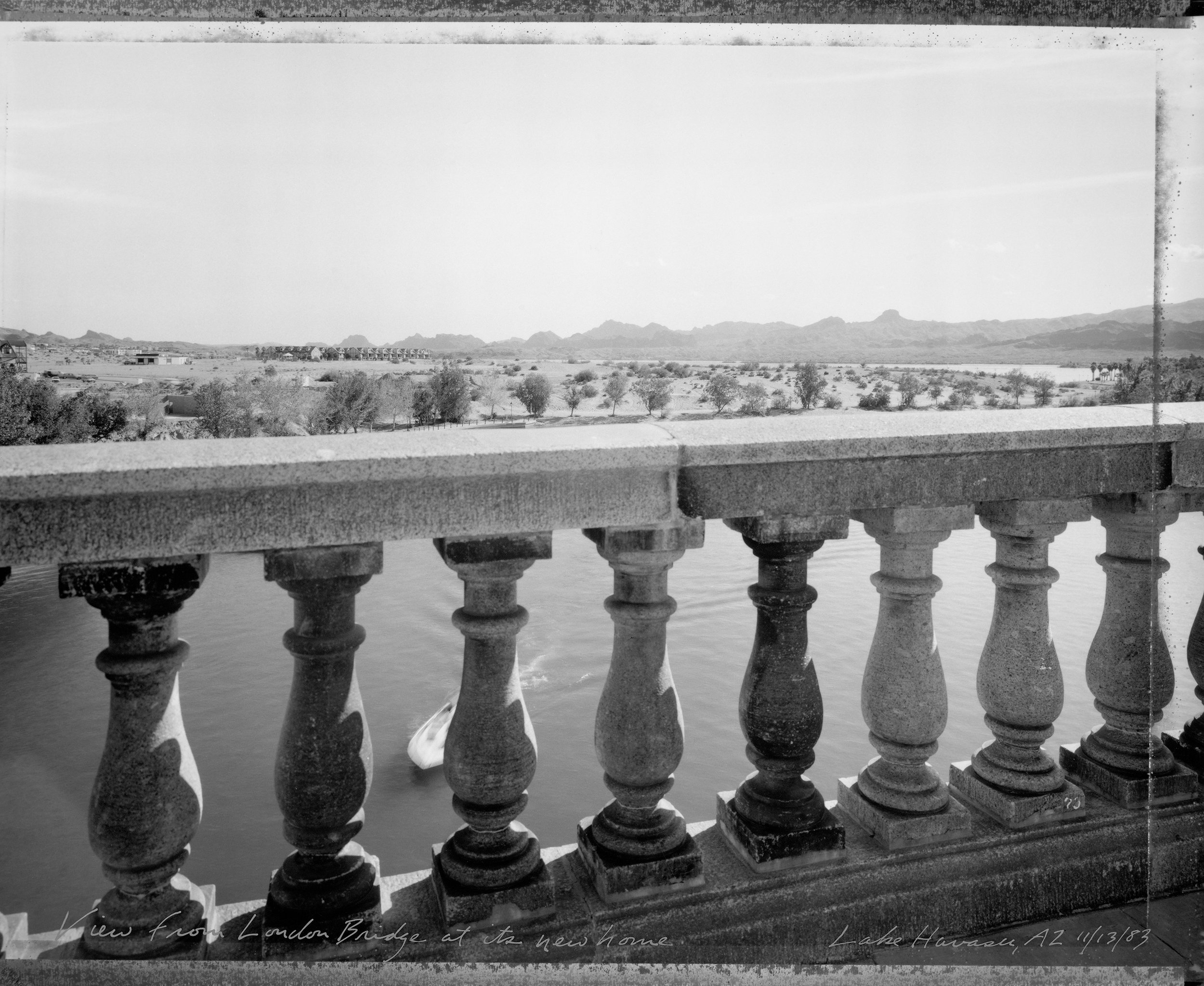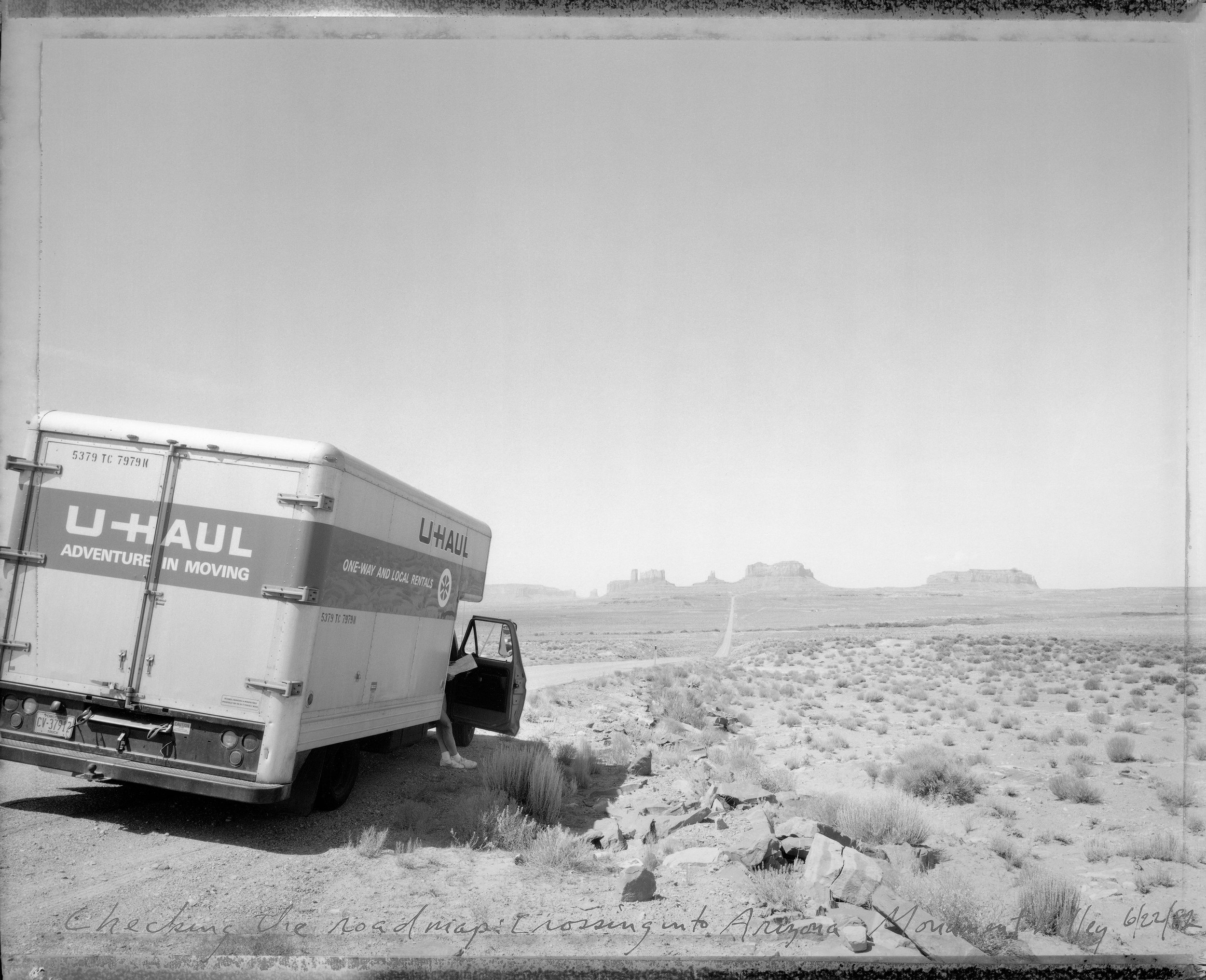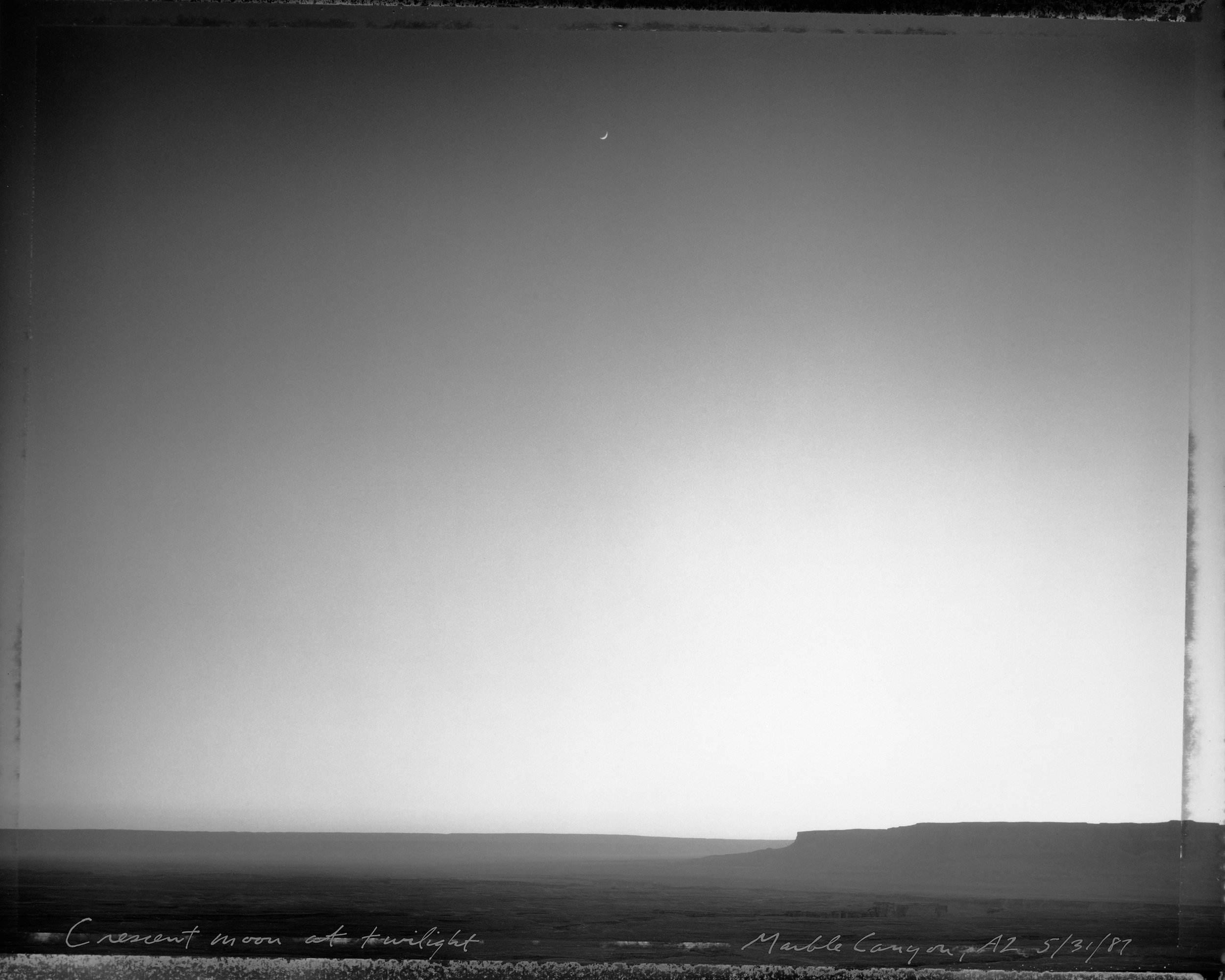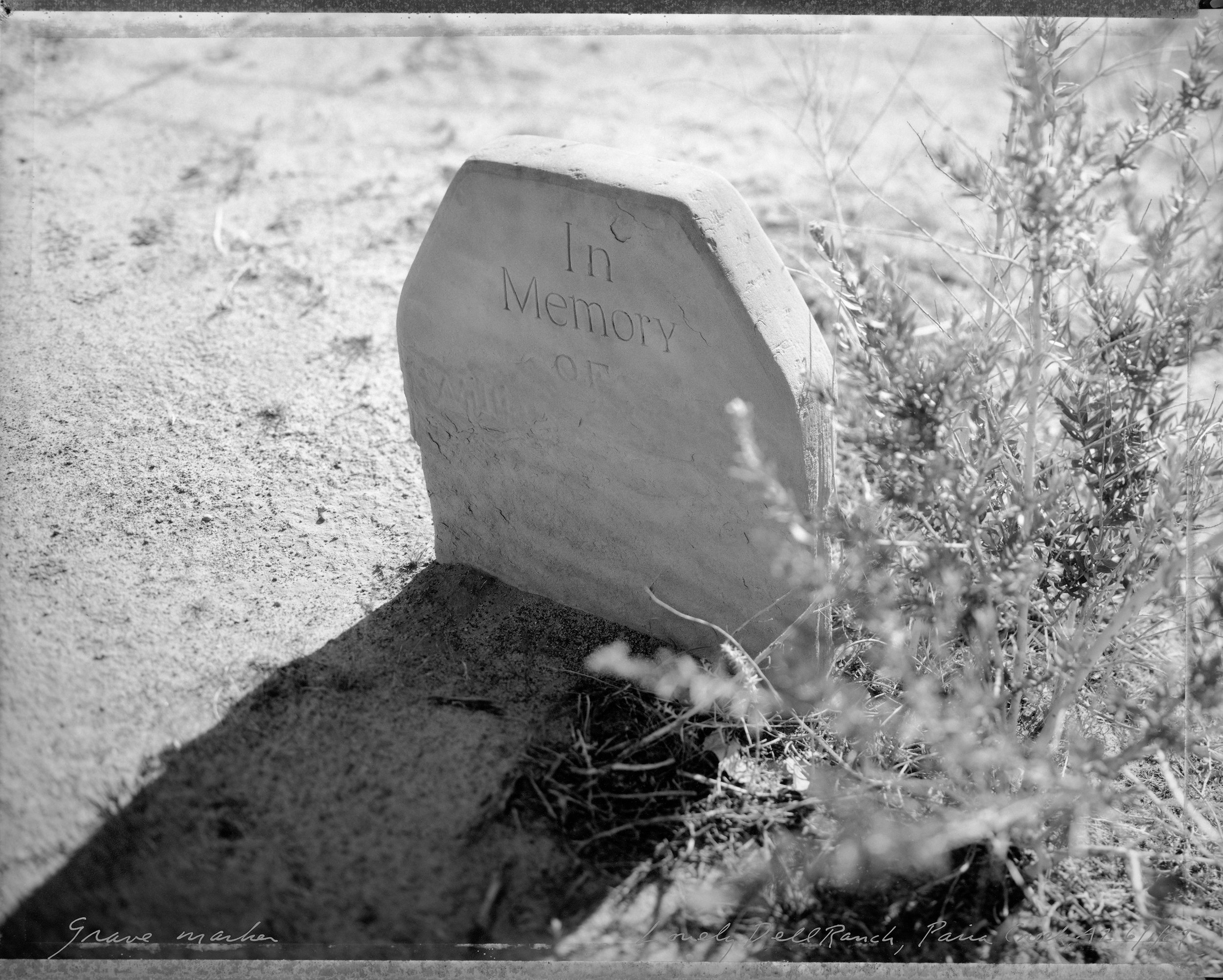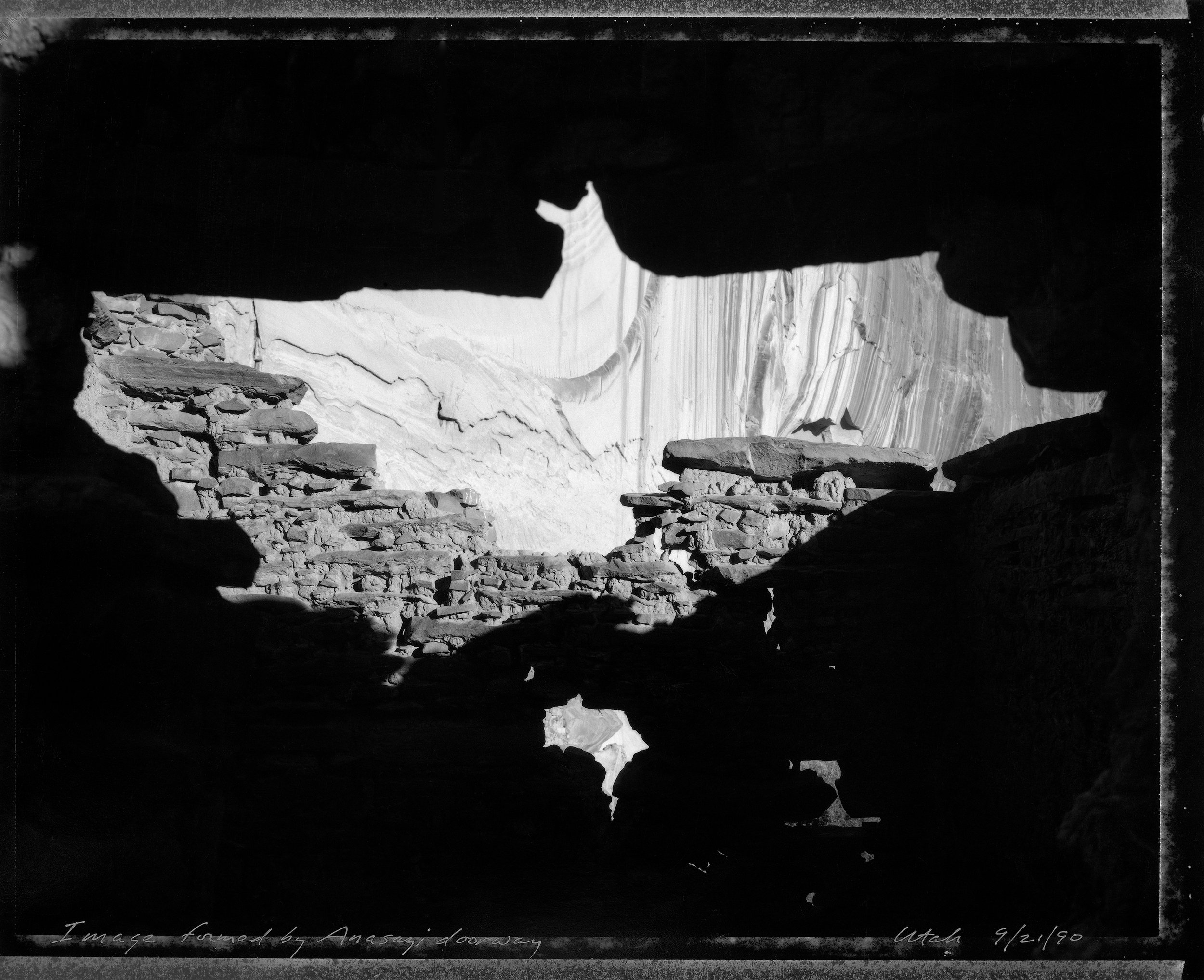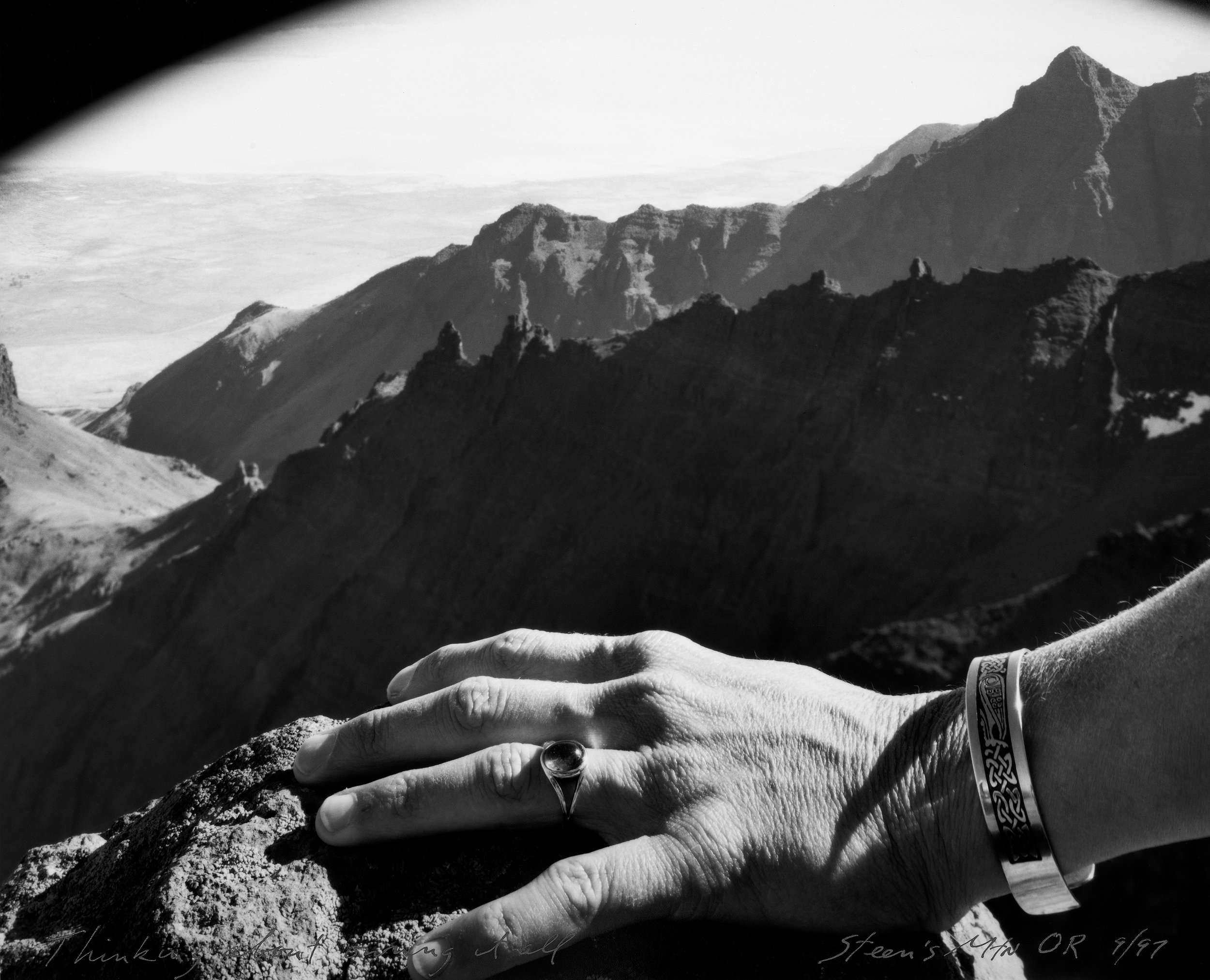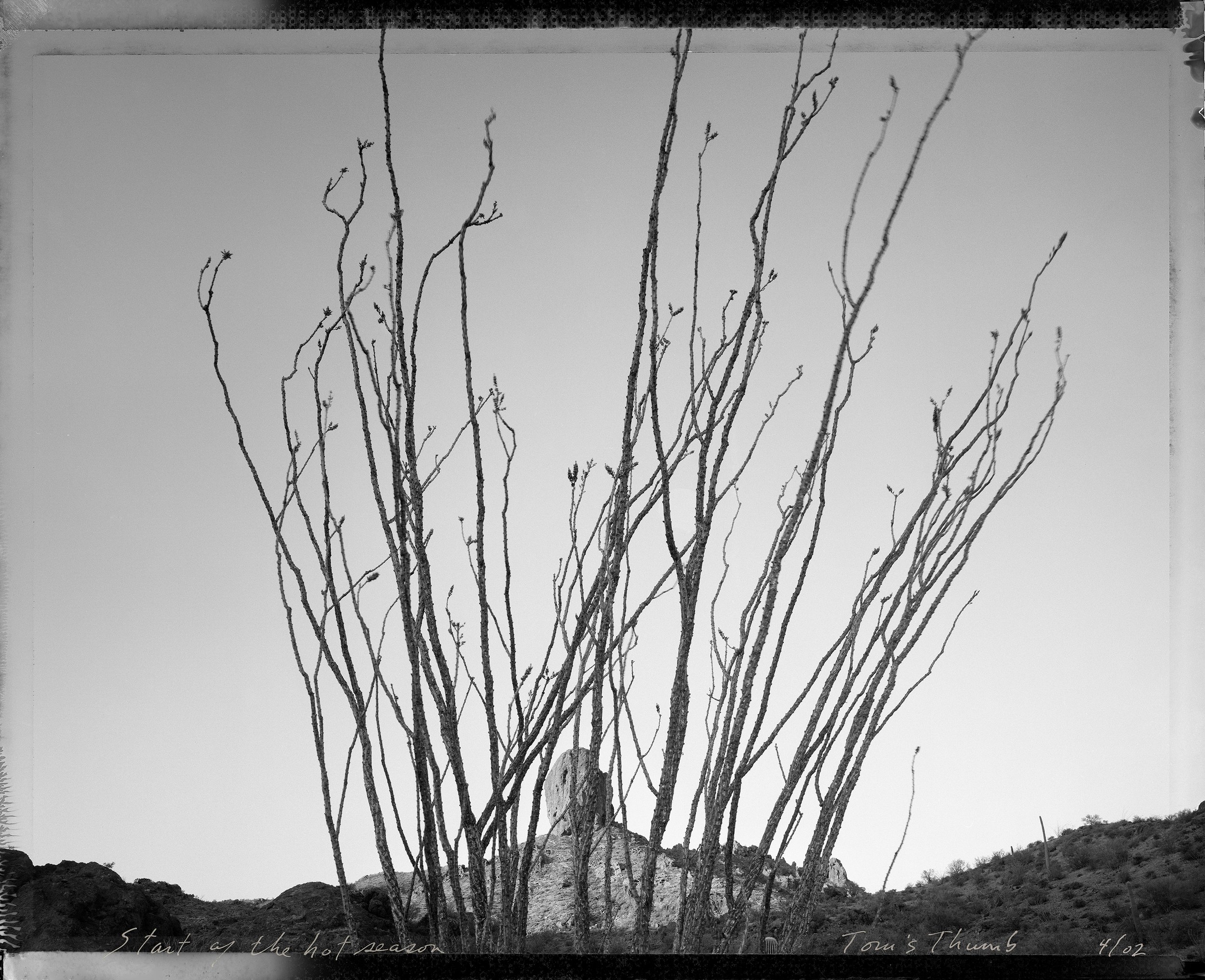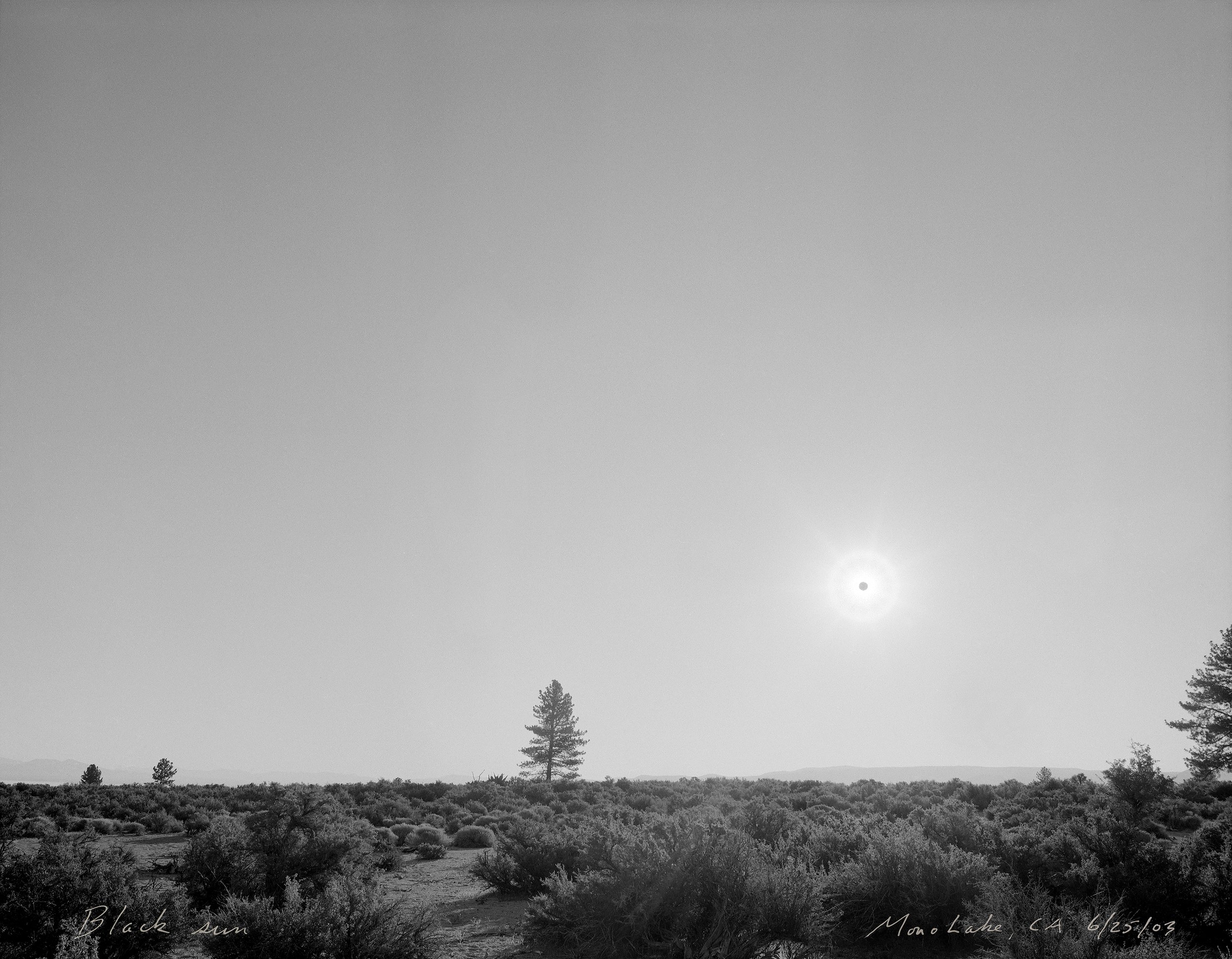1982-2004
REVEALING TERRITORY
This work began when I moved to Arizona in early 1982, and it continued until 2004, around the time Polaroid's Type 55 film was removed from the market. Initially the series owed its look to the photographs I'd been making of home and friends in Idaho, but the photographs became more focused on the landscapes of the Southwest and the history of issues related to human interaction with the land there.
I printed these photographs onto 16×20-inch black-and-white photo paper called Kodak Koda-bromine E3. The paper had a matte surface and was not something normally used for landscape photographs. The paper accentuated the middle gray tones of the image, and its surface and tonality were qualities I loved about the material. It seemed to fit the Polaroid film's tonal range very well, and I liked that it cut across the more dramatic traditions of the genre. Later, when the Kodak paper was discontinued, I printed on another matte paper made by liford.
I printed all of the image, including the ragged edges of the film that were the result of a paper mask that separated the Polaroid negative from its instant print during development. Normally these edges would have been cropped out during enlargement of the image. But I liked how they resembled and seemed to refer to the mottled edges of wet plate collodion negatives made by the survey photographers of the nineteenth century. The film's edges also brought attention back to the surface of the print. This was a way to acknowledge that the photograph was not a faithful representation of the land, but an artifact of process and vision.
The photographs in the series have titles written by hand in silver ink on the print surface. This began with the photographs I made in Idaho, and I first thought of it as a reference to the way nineteenth-century photographers wrote numbers or sometimes titles onto their negatives. But a reference to the snapshot was just as important, particularly to family albums from the early twentieth century, when it was common to neatly scrawl personal notations across images.
The book Revealing Territory came out in 1992 and reproduced a selection of the work finished about halfway through the series. Other books also drew on this work, including Traces of Eden (1986) and Desert Legends (1994). When this series began I thought I was starting a lifelong project. It was certainly the main focus of my practice for more than twenty years, and I made thousands of images for the series. But by the mid-1990s I started to reach a point of diminishing returns for the effort it was taking to continue the work, and I felt a need to refresh my roots in landscape photography. This contributed to a decision to return to rephotography with the Third View project. By 2004 Polaroid Type 55 was near the end of its production life, and the film was harder to obtain and less technically reliable. I ended this series at that time.
Man behind creosote bush, Phoenix, AZ 3/7/82
Plywood Tee-Pees, Meteor Crater, AZ 5/30/82
Petroglyphs in the Cave of Life, Petrified Forest, AZ, 5/31/82
Beneath the Great Arch, near Monticello, UT, 6/21/82
The Space Shuttle Columbia landing at Edwards Air Force Base, 500,000 spectators, 7/4/82
A portrait of the artist atop a small hill on his thirtieth birthday, 9/9/82
Bullet-riddled saguaro, near Fountain Hills, AZ, 11/21/82
Picnic on the edge of the rim, Grand Canyon, AZ, 2/12/83
Spiral carving facing east, Signal Hill, Saguaro National Monument, AZ, 5/7/83
Memorial Day Bathers, 107 degrees, Boulder City Beach, Lake Mead, NV, 5/29/83
Car passing snake, 5/29/83
Campsite reached by boat through watery canyons, Lake Powell, 8/20/83
View from London bridge at its new home, Lake Havasu, AZ, 11/13/83
Summit of Squaw Peak
Fallen cactus, Pinacle Peak, AZ, 3/4/84
Checking the Road map: crossing into Arizona, Monument Valley, 6/22/82
Longest day: Last light of the solstice, Carefree, AZ, 6/21/84
Casa Grande ruins with protective rain shelter, 12/16/84
Engineering oasis, Central Arizona Project. Canal awaiting water, 10/21/84
Rock face with Petroglyphs, Red Wash, AZ, 1/20/85
Target dummy, east of Scottsdale, AZ, 3/30/85
Mexican migrants drinking beer at the site of an inscription by Fray Marcos de Niza, 5/18/85
Casino, Boulder City, NV, 7/6/85
"U & me," Rocks along the Picacho Road, CA, 10/27/85
Nuclear generating station, Palo Verde, 50 miles from Phoenix, AZ, 1/4/86
Ventilated sedan, east of Parker, AZ, 1/5/86
Feet of Mortar, Driftwood Charlie's camp, Albondigas, CA, 3/1/86
Balancing rocks, road to Lee's Ferry, Marble Canyon, AZ 5/10/86
From left to right: Around Toroweap Point • Just before and after sundown • Beginning and ending with views used by J.K. Hillers • Over one hundred years earlier • Grand Canyon, 8/17/86
Bras decorating a juniper, Christmas Tree Pass, NV, 1/20/87
Rock drawings on brink of sunlight, Gila River bed, AZ, 1/21/87
Gun found in drifting sand, Kelso, CA, 1/22/87
Trophy used for target, McDowell Mountains, 2/7/87
Crescent moon at twilight, Marble Canyon, 5/31/87
Grave marker, Lonely Dell Ranch, Paria Creek, 6/1/87
Edward Abbey taking notes in Turkey Pen Ruins, Grand Gulch, UT, 5/17/88
Witness to sunrise, Miley Point, UT, 5/24/88
View of the Grand Canyon homage to Wm. Bell, east of Toroweap, 7/3/88
Under the dark cloth, Monument Valley, 5/27/89
Peering over Comb Ridge, near Bluff, Utah, 6/19/89
View from the truck driving below Comb Ridge, 6/19/89
Auto petroglygh, Canyon Lands, UT, 6/21/89
Last light on the Navajo Cliffs Navajo Reservation, 9/4/89
Arrowhead and bullet found at campsite used by hunters for centuries, Eagle Tail Mountains, 11/25/89
Cactus carved by gunfire, Tuscan, AZ, 1/27/90
Entering a narrow cave, Salt Creek, Utah, 5/9/90
Ancient art, Salt Creek, UT, 5/9/90
Cul de sacs: failed development, "Estrella," 7/17/90
Sign near Cameron, Navajo Reservation, 8/1/90
Image formed by Anasazi doorway, UT, 9/21/90
David photographing "Baseball Man," pictograph along the San Juan River, 9/24/90
Boatman's sandal print, San Juan River, 9/27/90
Dirt bike loop, west of Hanksville, UT, 4/18/91
Drinking rainwater from a pothole below Hack Canyon uranium mine, 5/23/92
Camper's lament: note left in abandoned cabin, Kofa Range, 3/16/93
Discarded doll with nurse plant, Darby Wells Road, 7/10/93
Cactus atop international border marker, 7/93
Saguaro with shirt, US-Mexico border, 7/10/93
Coyote crossing near I-10, West of Phoenix, AZ, 9/93
Night storm, Glendale, AZ 10/93
Boy with toy gun, Mexico, 11/93
Woman with house made of adobe and saguaro ribs, Sonora, 11/93
Ocotillo in moonlight along the Camino del Diablo, 11/23/93
Natalie, one week old, 1/11/94
Contemplating the view at Muley Point, UT, 5/13/94
Stone moved by unknown forces, "The Race Track," 10/23/95
Kyle looking at a bird's nest, Little Death Hollow Canyon, 5/15/96
Lena by the reflecting pool, Muley Point, 7/14/96
Natalie throwing rocks, Aravaipa Canyon, 11/96
Tea break at Teapot Rock, after O'Sullivan, Green River, WY, 8/11/97
Thinking about owning it all, Steen's Mountain, OR, 9/97
Byron checking positions of the moon with his laptop, Flaming Gorge, WY, 8:56 PM, 8/8/98
Emily practicing yoga, Grand Staircase, Escalante, UT, 8/11/99
Self-portrait with saguaro about my age, Pinacate Sonora, 10/29/99
First camp at Black Rock Desert: negative destroyed by heat, NV, 6/17/00
Viewing Thomas Moran at the source, Artist's Point, Yellowstone, 8/3/00
View from the tent at Pyramid Lake 7:45 am, Nevada, 9/16/00
Facing South, Sunrise at Black Rock, NV, 9/18/00
Start of hot season, Tom's Thumb Camp, 4/02
Black sun, Mono Lake, CA, 6/25/03
Fly, North Rim, Grand Canyon, 7/3/04
Related:
Desert Legends: Restorying the Sonoran Borderlands, with Gary Paul Nabhan
Henry Holt, New York, 1994
Traces of Eden: Travels in the Desert Southwest
David R. Godine, Boston, 1986
University of New Mexico Press, Albuquerque, 1992

